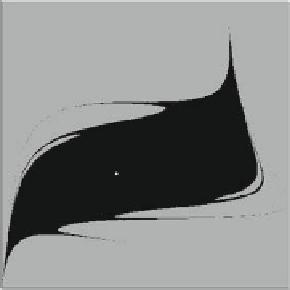Chemistry Reference
In-Depth Information
2.5
2.5
ε
ε
2
2
(
B
,
B
)
(
B
,
B
)
ε
ε
0
2.5
0
2.5
1
1
(a)
(b)
Fig. 5.8
The duopoly with heterogeneous players. From initial values in the
white region
the
system generates feasible trajectories, from initial values in the
grey region
, the trajectories become
infeasible. Here A
D
5, B
D
1, c
1
D
0:5, c
2
D
1:3 and a
2
D
0:9.(
a
) The speed of adjustment of
the first firm is a
1
D
1. The equilibrium is a stable focus. (
b
) The speed of adjustment of the first
firm is a
1
D
1:17. After the value of .a
1
=B;a
2
=B/ crosses the boundary H an attracting closed
invariant curve is created around the (now) unstable equilibrium
As the parameters a
1
and/or a
2
are further increased, the size of the attracting closed
orbit around the steady state increases, according to the Neimark-Hopf bifurcation
theorem, and consequently the long-run oscillations of the scale factors "
k
.t/ will
increase their amplitude until a contact between the boundaries of the attractor and
the boundary of the feasible region occurs. This contact represents a global bifur-
cation (called
final bifurcation
in Mira et al. (1996), or
boundary crisis
in Grebogi
et al. (1983)) that marks the disappearance of the attractor, because after the contact
the generic trajectory is infeasible.
We do not analyze these dynamic properties of the model in greater detail, as here
we are mainly interested in studying the conditions under which learning emerges.
However, putting together the information gained by the two numerical simulations
shown above, we can easily see what happens when the condition (5.112) holds
(which implies a high degree of heterogeneity between the two firms) and the param-
eters a
1
=B and/or a
2
=B are gradually increased in such a way that we obtain two
bifurcations which cause a transition between two different instability situations
separated by a “window” of stability, like in the bifurcation path represented by
the dashed line in Fig. 5.6c. Moving along that path by increasing the value of the
parameter a
1
, at first the equilibrium is unstable, with long-run dynamics character-
ized by oscillations of period 2. Then the learning process leads to a period halving
(or backward flip) bifurcation, after which the equilibrium becomes stable. Then, by
further increasing the speed of adjustment a
1
a supercritical Neimark-Hopf bifur-
cation occurs after which the equilibrium becomes unstable again, and the long-run
dynamics of the learning process are characterized by quasi-periodic oscillations
along a stable close invariant orbit around the unstable steady state. To conclude



Search WWH ::

Custom Search